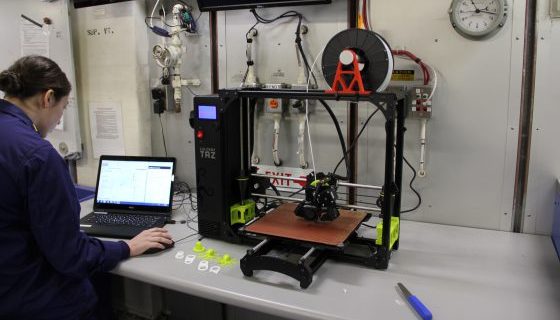The Coast Guard Research and Development Center in New London, Connecticut, is currently studying how the use of 3-D printing technology might improve mission readiness through logistical support, as the availability of spare parts can be important to mission completion.
In the current evaluation phase, 3-D printers are available for crew use on five Coast Guard cutters as well as at several operational shore units including Base New Orleans and the Surface Forces Logistics Center Engineering Services Division in Baltimore.
“This project presents an opportunity for operational units to innovate and design 3-D printed solutions to meet their needs, but to also explore the limitations and practical applications of additive manufacturing technologies,” said Lt. Steven Hager, Surface Domain lead with the Office of Research, Development, Test and Evaluation.
The utility of the 3-D printer is the ability to print parts that are not normally kept onboard, according to Capt. Joseph Dugan, who is program manager for the National Security Cutter Program. Additive manufacturing may also provide cost savings for the US Coast Guard. With some of its legacy cutters, replacement parts can be difficult to find.
“Sometimes manufacturers no longer make the parts, and need to retool a production line in order to make us the part we need,” Capt. Dugan said. “This can be time-consuming, and very costly to the government.”
Operations in remote areas like the Arctic also provide logistical challenges that could be overcome with 3-D printing. Coast Guard Cutter Healy (WAGB-20) has additive manufacturing capabilities onboard, and RDC researchers observed their use during the center’s just completed Arctic Technology Evaluation.
One of the earliest 3-D printing uses aboard a Coast Guard cutter was on Healy in 2013, when parts were needed to repair a remotely operated vehicle that was crushed in the ice. RDC researchers were able to successfully complete their project after replacement parts were printed.
For the evaluation phase, the RDC identified recent Coast Guard Academy graduates with computer-aided design backgrounds to serve as additive manufacturing liaisons for installation and training of operators.
For this initial evaluation of the technology, the RDC is focusing mainly on printers that are sized for a desktop and the use of polymers as the material. The polymers are wound on spools, “so the material is easy to store and transport,” explained Jason Story, RDC project manager for the Evaluation of Three-Dimensional (3-D) Printing Technology for Coast Guard Applications. Future efforts will focus on more robust materials including metals.
The project is also looking into options for recycling plastic to use in the printing of new parts. To accomplish this, the RDC developed a “paper-shredder” style of machine to grind the plastic and is integrating a shoe box-sized commercial-off-the-shelf machine to melt the plastic. “This could help to reduce waste on cutters by recycling some types of plastics into useful items,” said Story.
“The next step in the project will be development of a roadmap for wider integration of additive manufacturing into Coast Guard operations,” continued Story. “Or, charting the course forward for the use of 3-D printing.”






























































